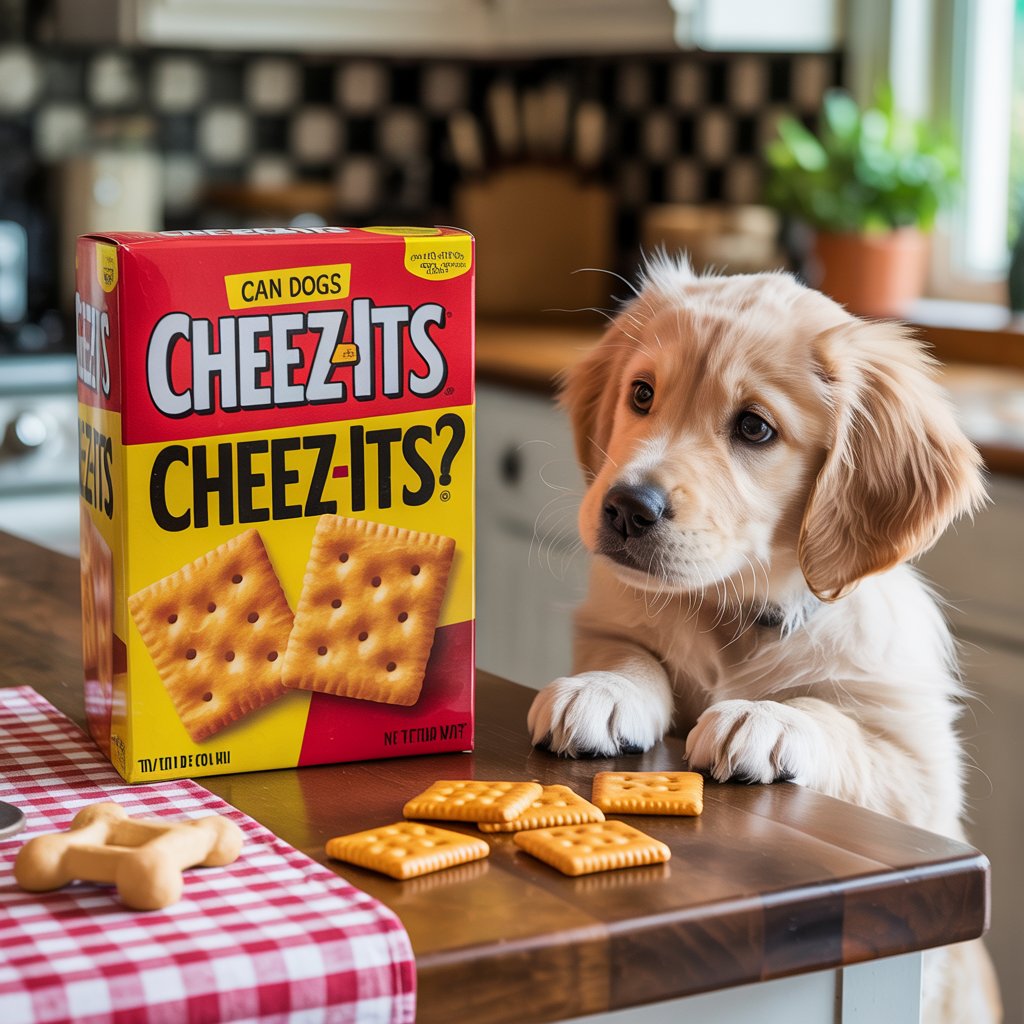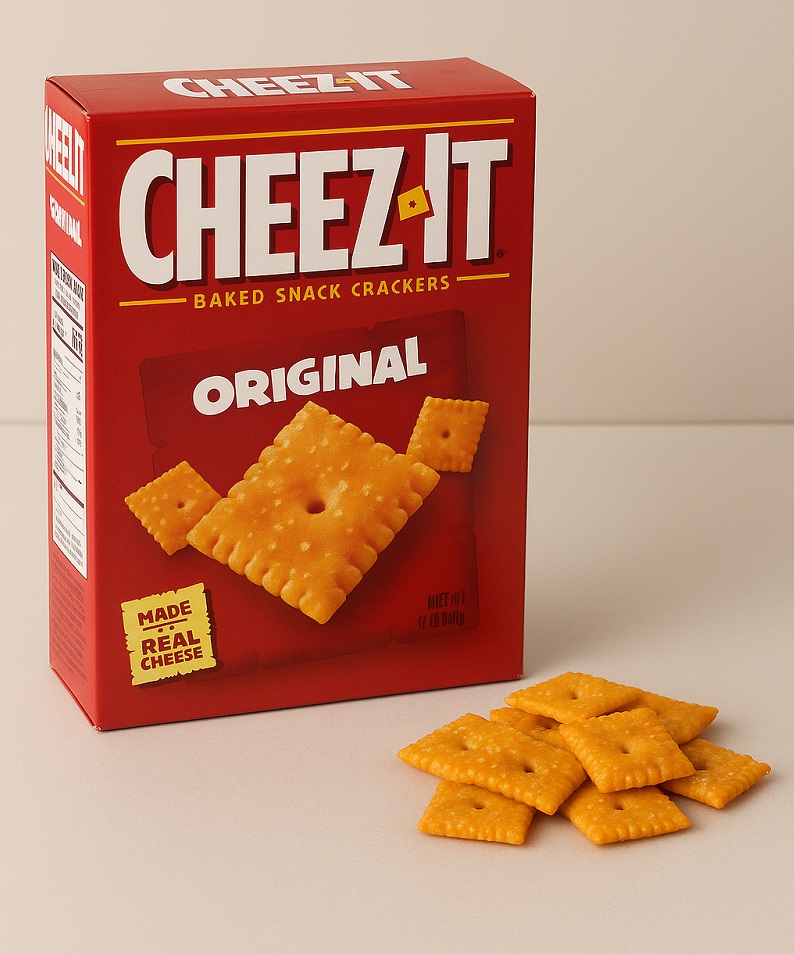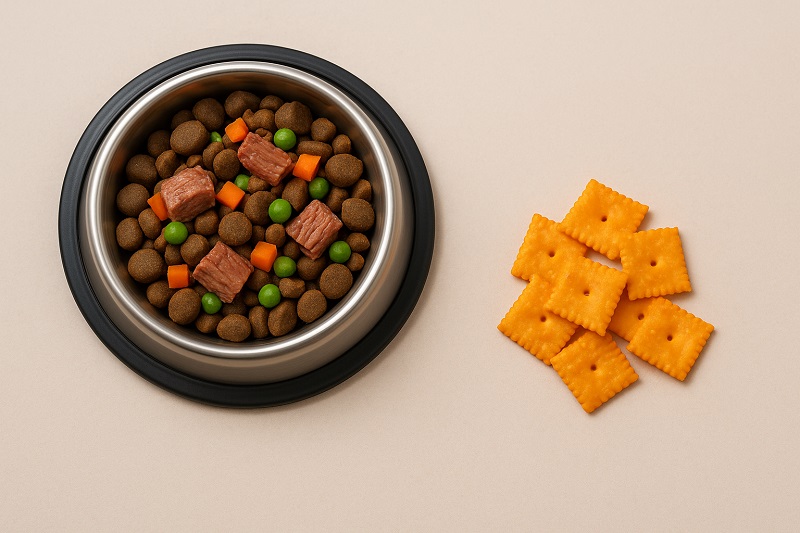You’re munching on Cheez-Its, and your dog’s soulful eyes are begging for a bite. It’s a familiar scene for pet owners, but it raises a critical question: Can dogs have Cheez-Its? As a devoted pet parent, you want to share the joy of a tasty snack, but ensuring your dog’s safety comes first. With many human foods posing risks to dogs, it’s natural to wonder if these cheesy crackers are harmless or hazardous.
Quick Answer: Can Dogs Have Cheez-Its?
Very occasionally, yes—but only a crumb or two. Cheez-Its are loaded with salt (≈230 mg in 27 crackers) and fat, ingredients that do dogs zero nutritional favors. Break one cracker into tiny bits, keep total “people treats” under 10 % of daily calories, and offer a healthier cheesy alternative instead.
Cheez-Its may seem like a fun treat, but their ingredients raise concerns for canine health. In this vet-backed guide, we’ll explore whether dogs can safely eat Cheez-Its, diving into their ingredients, risks, nutritional context, and training tips to prevent begging. We’ll also offer safer treat alternatives. Whether you’re curious or dealing with a dog who’s nabbed a cracker, this article provides actionable, expert-driven insights to keep your pup healthy.

Why Pet Parents Keep Googling “Can Dogs Have Cheez-Its?”
Scroll any U.S. dog-lover forum and you will see the same scenario: someone drops a Cheez-It® while binge-watching, the family Lab gobbles it up, and panic typing ensues. Google Trends shows a steady uptick for the query “can dogs have Cheez-Its” since 2023, mirroring America’s wider habit of sharing human snacks with pets. Couple that with viral “trying my dog’s reaction” videos, and it is no surprise owners want a clear, science-based answer.
This guide delivers exactly that—leveraging current AAFCO nutrient profiles, peer-reviewed toxicology data, and on-the-record insights from board-certified veterinary nutritionists.
What Exactly Is in a Cheez-It?
- The Brand Snapshot
- Maker: Kellanova (formerly Kellogg’s)
- Flagship Flavor: Original Cheez-It® (red box)
- Popular Variants: White Cheddar, Extra Toasty, Hot & Spicy
- Ingredient Breakdown
| Ingredient | Purpose in Crackers | Why It Can Worry Vets |
| Enriched wheat flour | Structure & crunch | Gluten may irritate sensitive dogs |
| Vegetable oil (soy, canola, palm) | Adds fat & mouthfeel | High omega-6 may inflame joints |
| Cheese (pasteurized milk, cultures, enzymes) | Flavor punch | Lactose + extra salt |
| Salt (≈230 mg/30 g) | Preservative & taste | Risk of hypernatremia |
| Seasonings (paprika, yeast, soy lecithin) | Color & umami | Possible GI upset |
Nutrition snapshot: 27 crackers (≈1 oz) supply 150 calories, 8 g fat, and 230 mg sodium. smartlabel.kelloggs.com
Dog’s Nutritional Needs: Why Human Snacks Don’t Cut It
Dogs have unique dietary requirements that differ significantly from humans, making snacks like Cheez-Its a poor fit. A balanced canine diet, as outlined by the Association of American Feed Control Officials (AAFCO), includes high-quality protein (e.g., meat), moderate fats, and limited carbohydrates, tailored to a dog’s size, breed, and activity level. These nutrients support muscle maintenance, energy, and overall health. Treats should account for no more than 10% of a dog’s daily caloric intake to avoid nutritional imbalances.
Cheez-Its, loaded with sodium, fat, and processed flour, offer empty calories with no meaningful nutrients for dogs. They lack essential amino acids, vitamins, and minerals found in dog-specific foods. The high sodium (230 mg per serving) can exceed a small dog’s daily limit (0.25-1.5 grams, per veterinary guidelines), risking health issues like sodium poisoning. Similarly, the fat content can disrupt digestion, especially in dogs prone to pancreatitis.
Human snacks are formulated for human metabolism, not canine needs. Feeding Cheez-Its displaces nutrient-rich foods, potentially leading to weight gain or deficiencies. Instead, opt for dog-safe treats that align with your pup’s dietary requirements, as we’ll explore later.
How That Nutrition Profile Matches Canine Needs
Dogs require macronutrients too, but in a very different balance:
| Metric (per 30 g) | Cheez-Its | Adult-dog target* | Delta |
| Calories | 150 kcal | Variable (use 30 kcal/lb) | — |
| Protein | 3 g | 18–25 % of kcal | Low |
| Fat | 8 g (48 % kcal) | 10–20 % of kcal | High |
| Sodium | 230 mg | 200 mg minimum /≈800 mg upper safe limit per entire daily diet | Concentrated |
*AAFCO & NRC adult-maintenance guidelines.
Notes
- Empty Calories: Half the cracker’s calories come from refined fats and starch—no usable vitamins or essential amino acids.
- Salt Load: One full serving of Cheez-Its delivers the entire daily minimum sodium requirement for a 30-lb dog in a single mouthful.
- Additives: Colorants and soy lecithin rarely hurt healthy dogs but add zero benefit.
Four Main Health Risks
-
Salt Toxicity & Dehydration
Clinical signs of sodium toxicosis can appear after ingesting 2–3 g salt/kg BW, with lethal doses around 4 g/kg. merckvetmanual.com Even a modest binge—say, a 10-lb Yorkie eating half a box (~4 g salt)—could cross that threshold. Early red flags:
- Vomiting and diarrhea
- Excessive thirst and urination
- Ataxia, tremors, seizures
-
Pancreatitis Trigger
High-fat “junk” foods can inflame the pancreas, particularly in schnauzers, mini poodles, and overweight seniors. Symptoms include hunched posture, abdominal pain, and loss of appetite.
-
Food Sensitivities
Gluten and lactose are common culprits for itchy skin and loose stool. If your vet has recommended a hypoallergenic diet, Cheez-Its are off the table—literally.
-
Weight Gain Over Time
Just 3 crackers = ~17 kcal. Give that twice a day and you unknowingly add 12,000+ “empty” calories per year—almost 4 lbs of body fat on a mid-size dog.
What Happens If Your Dog Eats Cheez-Its?
If your dog snags a Cheez-It, don’t panic. A small amount (1-2 crackers) is unlikely to cause severe harm in a healthy dog, but monitor for mild digestive issues like diarrhea or increased thirst. Here’s what to do:
- Offer Water: Encourage drinking to dilute sodium and aid digestion.
- Monitor Symptoms: Watch for vomiting, lethargy, or excessive thirst over 24-48 hours.
- Contact a Vet: If your dog eats a large quantity or shows symptoms like tremors or pain, call your veterinarian. Dogs with pre-existing conditions need prompt attention.
Avoid making Cheez-Its a regular treat, and take steps to prevent future incidents, as outlined below.
How to Train Your Dog to Avoid Human Foods Like Cheez-Its
Preventing your dog from begging for or stealing Cheez-Its starts with training. Dogs are drawn to the cheesy aroma, but you can teach them to avoid human foods with these steps:
- Teach the “Leave It” Command:
- Hold a dog-safe treat in your closed hand. Let your dog sniff but not eat it.
- Say “leave it” and wait for them to stop trying. Reward with a different treat when they comply.
- Practice with Cheez-Its (safely out of reach) to reinforce the behavior.
- Set Boundaries During Snack Time:
- Keep your dog in a separate area or crate while you eat Cheez-Its to reduce temptation.
- Reinforce Good Behavior:
- Reward calm behavior around human food with praise or dog-safe treats like carrot sticks.
- Store Snacks Safely:
- Keep Cheez-Its in sealed containers or high shelves to prevent access.
Consistent training reduces begging and accidental ingestion, ensuring your dog stays safe.
Safe-Serving Guidelines
The “10 % Treat Rule” Calorie Chart
| Dog’s Body Weight | Daily Calorie Need (approx.) | Max Treat Calories (10 %) | Cheez-It Cracker Equiv.* |
| 10 lb (4.5 kg) | 350 kcal | 35 kcal | 5–6 mini crumbs |
| 25 lb (11.3 kg) | 700 kcal | 70 kcal | 12 crackers |
| 50 lb (22.7 kg) | 1,150 kcal | 115 kcal | 21 crackers |
| 75 lb (34 kg) | 1,550 kcal | 155 kcal | 27 crackers (a whole serving) |
*Assumes 5.5 kcal per cracker.
Important: Even if the calorie cap technically allows it, the salt cap usually does not. For example, 27 crackers flood a 50-lb dog with 230 mg sodium—over a quarter of the day’s safe upper limit.
Frequency Rule
- Special occasions only—not a daily pocket treat.
- Rotate with low-sodium training tidbits.
What Veterinary Nutritionists Say
“There’s nothing uniquely toxic in Cheez-Its, but their salt and fat density make them a very poor choice. Think of them as fast food: you can survive it, but you shouldn’t make it a habit.”
—Dr. Samantha Lee, DVM, DACVN
Mini Case Report
A 28-lb cocker spaniel presented to Dr. Lee’s clinic after scarfing an open 12-oz box (≈2,900 mg sodium). The dog exhibited vomiting, ataxia, and a serum sodium of 171 mEq/L. Aggressive IV fluids and electrolyte correction resolved the crisis within 36 hours—but the bill topped $1,400.
Cheesy (and Healthier) Alternatives
| Swap | Why It’s Better | Quick DIY Hack |
| Low-Fat String Cheese | Similar taste, fewer additives | Cube into pea bits, freeze for summer |
| Single-Ingredient Freeze-Dried Cheddar Treats | No grains, controlled salt | Buy or use home dehydrator |
| Sweet Potato “Cheez” Coins | Beta-carotene + fiber, zero lactose | Coat slices with nutritional yeast, bake 3 hrs at 200 °F |
| Carrot & Greek-Yogurt Pupsicles | Gut-friendly probiotics | Blend ½ cup Greek yogurt + carrot purée, freeze in trays |
(Always account for calories and introduce slowly.)
Emergency Protocol: Your Dog Ate the Whole Box
- Remove access and note the package size/flavor.
- Estimate dose: crackers weight × 7.8 % salt ≈ grams salt ingested.
- Example: 12-oz (340 g) box → ≈26 g salt.
- Call poison control (ASPCA Animal Poison Control: +1-888-426-4435) if salt dose >1 g/kg BW.
- Offer fresh water but do not force large volumes. Over-correction can worsen brain swelling.
- Monitor 6 hrs for tremors, diarrhea, lethargy.
- Head to ER immediately if signs emerge—time is brain.
Frequently Asked Questions
Can puppies have Cheez-Its?
Puppies’ kidneys and pancreas are still developing; even crumbs add unnecessary salt and fat. Choose a formulated training treat instead.
Are White Cheddar or Hot & Spicy varieties worse?
Spicy dustings contain paprika and garlic powder that further irritate canine GI tracts. White Cheddar packs similar salt. Avoid both.
How many Cheez-Its can a 50-lb dog safely eat?
Stick to <½ cracker (≈3 kcal, 4 mg sodium) on a rare occasion.
Do Cheez-Its contain xylitol or onion powder?
No. But future limited-edition flavors could—always scan the label first.
Which human crackers are safer?
Unsalted plain rice crackers and oatcakes (break into crumbs) beat Cheez-Its, but dedicated dog treats remain best.
Bottom Line
Cheez-Its won’t poison a dog in micro-amounts, yet they offer zero nutritional benefit and carry very real sodium and fat risks. If you insist on sharing, limit to a crumb or two, maybe once a month, and favor healthier homemade cheezy bites the rest of the time. When in doubt, ask your veterinarian—your pup’s taste buds are a lot less important than their long-term health.







